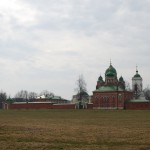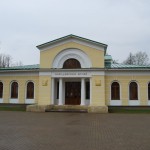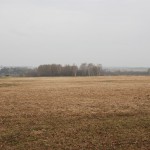Borodino Field
“And then we had come upon a plain:
Here’s room to fight with might and main!
There built we a redoubt.”
M. Y. Lermontov, Borodino
A Russian field. Were it not for the numerous memorial monuments, scattered today across its entire visible plane, this place – despite all of its agreeable looks of the central Russia landscape with a small river winding among the steep green banks, with white little churches and village houses, – this place would look no more special than thousands like it in Russia. But as soon as you speak out the name of one of the nearby villages – Borodino, it is as if this common landscape immediately changes its appearance in your eyes. Events and people pass before your mind’s eye – those, we have read about and heard so much of; a terrible picture of the great battle is drawn by imagination – the fierce fight of huge masses of armed men; cries and groans, silenced by the thunder of hundreds of cannons; fire; smoke; pitted and messed up dirt; blooded piles of dead bodies…
Borodino was a great battle of the invincible Napoleon, which became a fatal one for him. Borodino is a great testimony of the strong morale of the Russian people, who know how to stand their ground to the last ditch in the hour of dreadful danger for their Motherland.
The field of Borodino is the field of our great love and mourn, the field of unfading glory bought at the great price of blood. This field is memorable for us not only because of 1812. 130 years later, Russian regiments were fighting off another invasion here; in the same manner – not sparing their strength or lives, they shielded Russia with their bodies. Among the monuments of the Borodino Field there are some that stand on more recent, but not less revered graves.
The Borodino field is 12 kilometers west of Mozhaisk along the highway, which was formerly called the New Smolensk Post Road. The same distance separates it from the train station of Borodino by railway. Apparently, somewhere near the present railroad there was the Old Smolensk Road, which turned from the village of Utizy to Yelnia. The main events of the Battle of Borodino on August 26 (September the 7th) of 1812 took place mainly between these two Smolensk roads. It was here, where the most crucial military posts were stationed with the names that are deeply cut into our memory: Shevardino Redoubt, Bagration’s (Semenovskie) Flèches, Raevsky Battery… Many books are written about the Battle of Borodino. Numerous participants and eye witnesses of this event also wrote about it – those, who fought in both armies; military historians wrote about it in the years to follow. Among these authors, the greatest book by L. N. Tolstoy “War and Peace” has a special place; the grandiose events of this battle are described in it with great artistic power and historical accuracy, with the feeling of high national pride and love for the Fatherland. The following is its evaluation of the event, “As the direct consequence of the Battle of Borodino there was the unreasonable flight of Napoleon from Moscow… the perishing of the five hundred thousand invading army and the perishing of Napoleon’s France, upon which for the first time the hand of a stronger in spirit adversary was laid at Borodino.”
Why did Napoleon attack Russia? Historians closely studied this matter from all points of view, keeping in mind the overall political situation of that time, other particular comparatively minor reasons, or the Napoleon’s own statements, or the evaluation of his personality…
If one tries to relate briefly one of the versions, which is based, by the way, on the words of the emperor himself, the grandiose plan of his was as follows: to destroy the knowingly weaker Russian army, force Russian Tsar into the humiliating plea for peace, and, after signing a favorable peace treaty, join Russian troops (just like many others) to his great and invincible army, so that having established a new order in the conquered country, it would quickly march on to Himalayas, toward India. Meanwhile, “his brother” (as he called him) – Emperor Alexander I, would remain as Russian tsar, and Russia would join the friendly family of European nations, ruled by Napoleon; great grace would come upon all, as all the nations hail in unison, “Vive l’Empereur!”
On June 24 of 1812, the “twelve-language” army of Napoleon led by the Emperor crossed the Russian border. The quantity and condition of the Russian troops, affected by the meaningless marching drills under Pavel I, was indeed inferior to the enemy. On top of it, the mediocrity of Alexander I as an army commander, bitter strife between Barclay de Tolly, Bagration, and other generals, and corruption among intendants created additional difficulties.
But the nation, the army and the tsar, who realized that after the defeat at Austerlitz and the peace treaty of Tilsit the country’s dignity was marred, were one in their unwillingness to have any peace negotiations, while even one of the enemy’s soldiers had his foot in Russia. The chief objective of the Napoleon’s plan also could not be fulfilled – to inflict a quick defeat to the Russian army. The army was shying away from the decisive battle, tiring out the enemy in hard-fought rearguard actions and destroying everything after themselves. The French, who hoped for some rest and well-fed life in the conquered cities, could only find a desert there in flames of fire.
This strategy of preserving the army, according to which territories were temporarily sacrificed, was first carried out by Barclay and then by Kutuzov, who replaced him; and it was a forced measure. The army commanders were always confronted with the choice, “…out of two necessary evils the lightest one had to be chosen; it was better to lose a part for a time, then to lose the whole thing forever.” At the same time, Kutuzov realized that he could not avoid a pitched battle.
Everybody was longing for the real big fight – both the soldiers and the generals. Hatred for invaders and offended feeling of national pride of the citizens of the great country united everyone. “The die was cast. The Russian Army stopped and turned around to face the on-coming Napoleon.”
Two days before the decisive battle, the defenders of the Shevardino Redoubt, which was originally built to strengthen the left flank of the Russian army, were the first to take the blow. Even then, a fierce fight with the outnumbering forces of the enemy, which lasted for one whole day of August 24 (September 5th), demonstrated the desperate will of the Russians to fight and not to retreat even a step back, “this fight being so unequal that the French could not understand how it could last for so long.”
On August 26 (September 7), in the morning, Napoleon was on the captured Shevardino Redoubt. As he saw the rising sun in the east, he exclaimed, “This is the sun of Austerlitz!”
According to the information of an eye-witness and historian of the events of 1812, Klauzevich (who served at the command headquarters of the Russian Army), before the start of the Borodino Battle the balance of forces was as follows: the Russians had 112 thousands of troops and 640 cannons; the French had 130 thousands and 587 cannons. The battle started with an attack on village Borodino, from which the French at the cost of great losses managed to knock out our jägers, but the main events unfolded at the left flank of our army after 5 o’clock in the morning, where Bagration was standing at the Semenovsky ravine. The defense of the Bagration’s Flèches was so fierce that for over six straight hours all the attacks of the French were fought back with terrible losses for them. It was the bloodiest fight. The Flèches changed hands several times; they were all covered with dead bodies of people and horses. Napoleon sent 400 cannons there, more than two thirds of his artillery. Bayonet attacks and counterattacks followed one another, cannon balls, bullets, canister shots mowed down both the defenders and the assailers.
It is not known, how the battle for the Flèches would have ended, if Bagration had not been lethally wounded. “It seemed as if the soul departed from the entire left flank after this person’s death,” as one of the eye-witnesses stated. In the official documents the capturing of the Flèches by the French is also explained by Bagration’s death.
The fight for the Raevsky Battery, which was located in the center of our positions, was just as fierce. During the many-hour defense of this hilltop battery, Russian soldiers and generals demonstrated such readiness to sacrifice themselves and such negligence for death that had not been known before that day. A terrible carnage of huge masses of attackers and defenders during the last storm of the Raevsky Battery, when no captives were taken and the survivors were pierced with bayonets, was the last great act of the Battle of Borodino. The cannons were still roaring, single cavalry clashes still took place, but the battle was drawing to an end. How should one estimate its result? Neither Napoleon, nor his generals knew the answer to this question. “Despite the significantly thinned out lines of the Russian army, not only its flight was out of the question, but even its retreat.”
Kutuzov, who commanded the battle from a hill near the village of Gorki, regarded the results as victorious for the Russian army. There was even a point when some thought that Kutuzov would make the decision to attack the next day. But the next morning, a terrible picture of huge losses became obvious – 58 thousand people, one half of the army, including many officers and generals, was lost. The French lost over 50 thousand and 47 generals.
We cite the words of L. N. Tolstoy again, “Not Napoleon alone…, but all generals, …all soldiers of the French army… had the same sensation of terror as they faced the enemy, who, having lost half of his army, was still standing as fiercely at the end, as he was at the beginning of the battle.”
And this is what Napoleon said not long before his death, “Of all my battles the most terrible was the one I fought at Moscow. The French showed themselves to be worthy of victory, but the Russians proved themselves to be worthy of being invincible.”
The acquaintance with the field of Borodino can be started by its general observation from a high hill over the village of Gorki. It was on this very hill where the observation point of Kutuzov on the day of the battle was. It is marked with an obelisk with an eagle on top of it. They said that on this spot over Kutuzov’s head an eagle was flying in the beginning of the battle, and the commander greeted it as a sign of victory by taking off his hat.
This obelisk and 34 more monuments, which are standing on the hills, on the ravines’ slopes and spring banks, were set here in 1912 in commemoration of the centenary of the great battle. Most of the monuments were built at the expense of free-will donations of soldiers and officers, who served in the military regiments bearing the names they inherited from those fighting in the field of Borodino. They stand in those places where during the terrible battle their famed brothers in arms fought to the bitter end.
Next to those monuments, now there are memorial signs on the communal graves of their glorious descendants, who defended Moscow in 1941-1942.
In 1962, in the year of the 150-th anniversary of the Battle of Borodino, a monument was set on the Raevsky Battery. Simple black tombstone over the grave of glorious Bagration, whose remains were brought here in 1839 according to the request of the 1812 hero, Denis Davydov, also stands here.
Close to the famous Shevardino Redoubt, at the site of the command point of Napoleon, the only French monument was set in 1912 with an inscription, “To the Dead of the Great Army.”
In the center of our troops at that time, not far from the Raevsky Battery, there is a building of the military-history museum of Borodino with an exposition, which gives a detailed description of the events of the famous battle. On the Borodino Flèches in 1839-1859, Spaso-Borodinsky Monastery was built; in its hotel in the fall of 1865, L. N. Tolstoy was working on his novel “War and Peace.” Inside the monastery there is a beautiful Spasskaya Church, which served as a sepulcher for the Tuchkovs family. It was erected in 1820, by the widow of General A. A. Tuchkov, who was killed at this spot on the day of the Battle of Borodino.
In the village of Borodino the Church of Nativity (Rozhdestvenskaya) is preserved, built in 1697-1701, which witnessed the great battle, its huge bitter losses, unprecedented heroism and mighty men’s true grit… It seems to tell us, who live in the present, echoing M. Y. Lermontov’s words, “You’ll never know such fights as this!”
This year, in 2012, the 200-th anniversary of the Battle of Borodino will be celebrated. Several bronze commemorative medals have been struck.
Material is taken from: http://www.towns.ru



